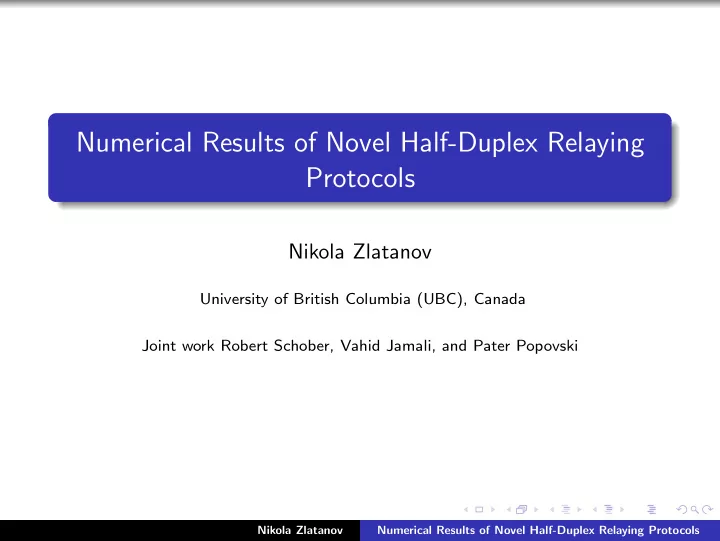

Numerical Results of Novel Half-Duplex Relaying Protocols Nikola Zlatanov University of British Columbia (UBC), Canada Joint work Robert Schober, Vahid Jamali, and Pater Popovski Nikola Zlatanov Numerical Results of Novel Half-Duplex Relaying Protocols
Outline X 1 Y 1 X 2 Y 2 Source Relay Destinat. We will present numerical results of three novel relaying protocols for the two-hop half-duplex (HD) relay channel. Protocol 1: Achieves the capacity of the two-hop HD relay channel in the absence of fading. Protocol 2: Improves the average achievable rate of the two-hop HD relay channel when fading is present. Protocol 3: Improves the outage probability of the two-hop HD relay channel when fading is present. Nikola Zlatanov Numerical Results of Novel Half-Duplex Relaying Protocols
Protocol 1 3 0.8 Capacity Capacity 0.7 Previous best known achievable rate 2.5 Previous best known achievable rate Rate (bits/use) 0.6 Rate (bits/use) 2 0.5 1.5 0.4 0.3 1 0.2 0.5 0.1 0 0 −10 −5 0 5 10 15 20 25 30 0 0.1 0.2 0.3 0.4 0.5 0.6 0.7 0.8 0.9 1 SNR in dB P ε (a) AWGN (b) BSC N. Zlatanov, V. Jamali, and R. Schober, “Capacity of the Two-Hop Half-Duplex Relay Channel,” Submitted to IEEE Trans. on Inform. Theory Nikola Zlatanov Numerical Results of Novel Half-Duplex Relaying Protocols
Protocols 2 and 3 0 5 10 Our protocol Our protocol Previous protocol Average rate (in bits/symb) Previous protocol 4 Outage probability −2 10 3 2 −4 10 1 −6 0 10 −5 0 5 10 15 20 25 30 0 10 20 30 40 50 SNR in dB SNR in dB (a) Protocol 2 (b) Protocol 3 N. Zlatanov, R. Schober, and P. Popovski, “Buffer-Aided Relaying with Adaptive Link Selection,” IEEE J. Select. Areas Commun. , vol. 31, pp. 1530–1542, Aug. 2013. N. Zlatanov and R. Schober, “Buffer-Aided Relaying With Adaptive Link Selection - Fixed and Mixed Rate Transmission,” IEEE Trans. Inform. Theory , vol. 59, pp. 2816–2840, May 2013. Nikola Zlatanov Numerical Results of Novel Half-Duplex Relaying Protocols
Recommend
More recommend